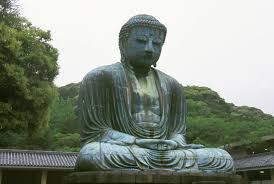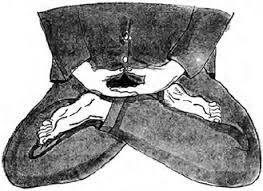 The history of Chinese Zen raises one problem of great fascination. Both Rinzai and Soto Zen as we find them in Japanese monasteries today put enormous emphasis on za-zen or sitting meditation, a practice which they follow for many hours of the day – attaching great importance to the correctness of posture and the way of breathing which it involves. To practice Zen is, to all intents and purposes, to practice za-zen, to which the Rinzai School adds sanzen, the periodic visits to the master (roshi) for presenting one’s view of the koan. However, the Shenhui Ho-chang I-chi records the following conversation between Shen-hui and a certain Ch’eng:
The history of Chinese Zen raises one problem of great fascination. Both Rinzai and Soto Zen as we find them in Japanese monasteries today put enormous emphasis on za-zen or sitting meditation, a practice which they follow for many hours of the day – attaching great importance to the correctness of posture and the way of breathing which it involves. To practice Zen is, to all intents and purposes, to practice za-zen, to which the Rinzai School adds sanzen, the periodic visits to the master (roshi) for presenting one’s view of the koan. However, the Shenhui Ho-chang I-chi records the following conversation between Shen-hui and a certain Ch’eng:
The Master asked Zen Master Ch’eng: “What method must be practised to see into one’s own nature?”
“It is first of all necessary to apply oneself to the practice of sitting cross-legged in samadhi, awaken prajna in oneself. By prajna one is able to see into one’s own nature.”
(Shen-hui:) “When one practices samadhi, isn’t this a deliberate activity of the mind?”
(Ch’eng:) “Yes.”
(Shen-hui:) “Then this deliberate activity of the mind is an activity of restricted consciousness, and how can it bring seeing into one’s own nature?”
(Ch’eng:) “To see into one’s own nature, it is necessary to practice samadhi. How could one see it otherwise?”
(Shen-hui:) “All practice of samadhi is fundamentally a wrong view. How, by practising samadhi, could one attain samadhi?”
The following story is also told of Huai-jang, initiating into Zen his great successor Ma-tsu (died 788), who was at the time practising sitting meditation at the monastery.
“Your reverence,” asked Huai-jang, “What is the objective of sitting in meditation?”
“The objective, “answered Ma-tsu, “is to become a Buddha.”
Thereupon Huai-jang picked up a floor-tile and began to polish it on a rock.
“What are you doing, master?” asked Ma-tsu.
“I am polishing it for a mirror,” said Huai-jang.
“How could polishing a tile make a mirror?”
“How could sitting in meditation make a Buddha?”
On another occasion Huai-jang said:
To train yourself in sitting meditation [za-zen] is to train yourself to be a sitting Buddha. If you train yourself in za-zen, (you should know that) Zen is neither sitting nor lying. If you train yourself to be a sitting Buddha, (you should know that) the Buddha is not a fixed form. Since the Dharma has no (fixed) abode, it is not a matter of making choices. If you (make yourself) a sitting Buddha this is precisely killing the Buddha. If you adhere to the sitting position, you will not attain the principle (of Zen).
This seems to be the consistent doctrine of all the T’ang masters from Hui-neng to Lin-chi. Nowhere in their teaching was any instruction in or recommendation of the type of za-zen which is today the principal occupation of Zen monks. On the contrary, the practice is discussed time after time in the apparently negative fashion of the three quotations just cited.
 It could be assumed that za-zen was so much the normal rule of the Zen monk’s life that our sources do not bother to discuss it….Alternatively, it could be assumed that the type of za-zen under criticism is za-zen practised for a purpose, to “get” Buddhahood, instead of “sitting just to sit.” This would concur with the Soto objection to the Rinzai school with its method of cultivating the state of “great doubt” by means of the koan. While the Soto is not quite fair to the Rinzai in this respect, this would certainly be a plausible interpretation of the early master’s doctrine. However, there are several references to the idea that prolonged sitting is not much better than being dead. There is, of course, a proper place for sitting – along with standing, walking, and lying – but to imagine that sitting contain some special virtue is “attachment to form.” Thus in the T’ang-ching Hui-neng says:
It could be assumed that za-zen was so much the normal rule of the Zen monk’s life that our sources do not bother to discuss it….Alternatively, it could be assumed that the type of za-zen under criticism is za-zen practised for a purpose, to “get” Buddhahood, instead of “sitting just to sit.” This would concur with the Soto objection to the Rinzai school with its method of cultivating the state of “great doubt” by means of the koan. While the Soto is not quite fair to the Rinzai in this respect, this would certainly be a plausible interpretation of the early master’s doctrine. However, there are several references to the idea that prolonged sitting is not much better than being dead. There is, of course, a proper place for sitting – along with standing, walking, and lying – but to imagine that sitting contain some special virtue is “attachment to form.” Thus in the T’ang-ching Hui-neng says:
A loving man who sits and does not lie down;
A dead man who lies down and does not sit!
After all these are just dirty skeletons.
Even in Japanese Zen one occasionally encounters a Zen practice who lays no special emphasis upon za-zen , but rather stresses the use of one’s ordinary work as the means of meditation. This principle underlies the common use of such arts as “tea ceremony,” flute playing, brush drawing, archery, fencing, and ju-jutsu as ways of practising Zen. Perhaps, then, the exaggeration of za-zen in later times is part and parcel of the conversion of the Zen monastery into a boys’ training school. To have them sit still for hours on end under the watchful eyes of monitors with sticks is certainly a sure method of keeping them out of mischief.
Yet however much za-zen may have been exaggerated in the Far East, a certain amount of “sitting just to sit” might well be best thing in the world for the jittery minds and agitated bodies of European and American – provided they do not use it as a method to turning themselves into Buddhas.
Source: The way of Zen, by: Alan W. Watts